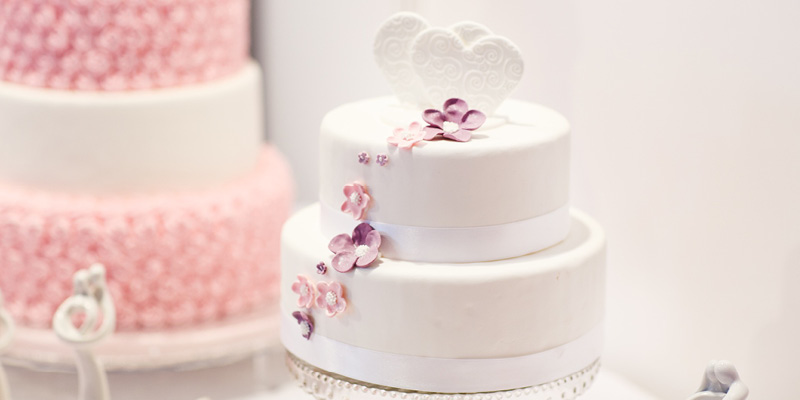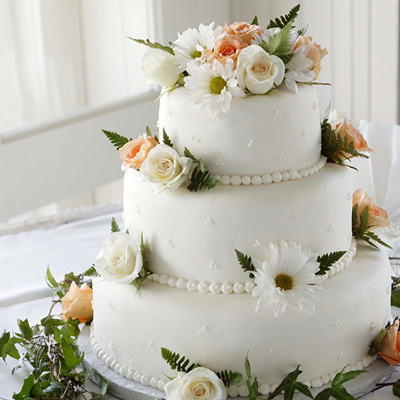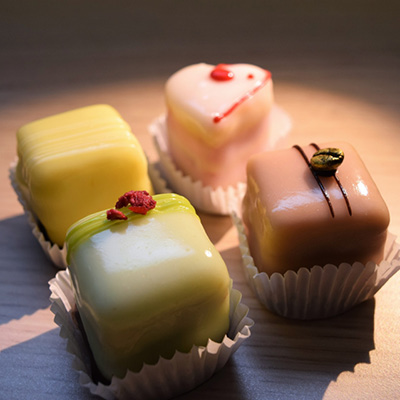Poured and Rolled Fondant

The Difference Between Poured and Rolled Fondant with Recipes for Classic and Quick Versions for Each
By Renee Shelton
There are two kinds of fondant - one - a creamy soft icing that can be melted and used for dipping eclairs and pouring over cakes, and the other - a soft pliable dough that can be kneaded, rolled, and shaped for decorations.
Poured Fondant
Poured fondant is very stiff when cool, but when heated becomes a liquid that can be poured or used for dipping, and sets right back up after it is cooled. Wayne Gisslen in Professional Baking defines it as "a sugar syrup that is crystallized to a smooth, creamy white mass...[and] when applied, it sets up into a shiny, nonsticky coating."
Most recipes will have glucose and sometimes an acid like cream of tartar which works to invert some of the sugar to get the proper crystallization in the finished fondant. Adding too much or too little will yeild a product that is too soft or too hard. The process must be performed perfectly or the fondant will fail to set up with the smooth, shiny non-sticky sheen - which is the hallmark of poured fondant.
Poured fondat is difficult to make perfectly and despite the relatively short number of ingredients, a lot of elbow grease will go into the fondant to make it perfect. The extra work will pay off, though.
How To Use Poured Fondant
Heat it over a bain marie or double boiler, stirring constantly, and taking care not to heat it past 100 degrees F. If the fondant is too thick, then add a very small amount of simple syrup to get the perfect consistency. The fondant can be used for dipping and for pouring at this point.
Poured fondant in the solid state (firm, cold) can be kneaded and colored or flavored to use inside peppermint patties and other candies. Just color, flavor, roll out or form into disks, then dip.
Recipes for Poured Fondant and Poured Icing
A classic fondant recipe is below along with a quicker poured icing recipe that is used in the same way.
Classic Fondant
- 2 cups sugar
- 2/3 cup water
- 1 tablespoon glucose (no substitutions)
- Prep: Sprinkle a large slab of marble or a large, heavy, smooth surfaced baking sheet with cold water (marble is best).
- Over medium heat, stir the sugar, water, and glucose in heavy saucepan gently until the sugar has dissolved. Increase temperature and bring to boil. Cover pot and boil for three minutes. Remove lid and place in candy thermometer. Continue to boil until the temperature reaches 240 degrees F, soft ball stage. Remove from heat and immediately dip the bottom of the pan into large tub (or sink) of cold water to stop the cooking.
- Pour this hot syrup onto the prepared marble and leave to cool for a couple of minutes. Using a damp metal spatula or metal scraper, lift the edges of the syrup and fold it back into the center. Keep doing this (folding the edges to the center) until the mixture turns glossy, and is pale yellow in color. Then use a heavy wooden spoon to work the mixture in a continuous figure eight for about 5 to 10 minutes. Keep doing this action until the mixture turns white, is crumbly, and stirring with the spoon becomes extremely difficult.
- Moisten hands and knead the fondant for about 5 to 10 minutes, or until the mixture feels moist and is perfectly free of lumps. Use the metal scraper to lift the fondant if it sticks to the surface. Form the fondant into a ball and place it on a moistened plate. Cover with damp cloth, and leave it in a cool place for 12 hours to ripen. Dust your work surface with sifted powdered sugar, and place the fondant on that. Press it out flat. If coloring, make slits in the fondant and drop the coloring into those slits. Knead well and use as desired.
- If this is to be melted, melt very slowly over low heat. The shine will be lost if it is too hot.
Quick Poured Fondant Icing
- 6 cups sifted confectioner's sugar
- 1/2 cup water
- 2 tablespoons light corn syrup
- 1 teaspoon almond extract
- Food coloring, if using
- Cover cake with buttercream, then let stand for 15 mintues if a crusting type and chill for 15 minutes if its non crusting. If making small petit four cakes, ice the sheet cake with a buttercream and cut into squares. Covering the cake with buttercream will keep crumbs way.
- Place sugar, water corn syrup in a heavy saucepan. Stir until mixed. Cook mixture over low heat, making sure the icing doesn't go over 100 degrees F. Remove from heat and add in the extract and the food coloring if using.
- Arrange the cakes or mini cakes on a cooling rack set over a sheet pan to catch the excess icing as you pour. Start by pouring in the center of each cake and pour just enough to cover the top plus extra for the sides (it will run down). Use a spatula to cover up and smooth over any spots you may have missed. If the icing cools too much as you are covering the cakes, you can reheat it, making sure the temperature doesn't go above 100 degrees C.
- Let the icing set up before moving to a cake plate or platter.

Rolled Fondant
Rolled fondant can be purchased in just about any shade or color commercially, but is relatively easy to make it yourself at home. The flavor will be better as well as some brands will be quite plastic in flavor.
The first is a classic rolled fondant using glycerine to help keep it smooth and pliable. It makes an excellent rolled fondant perfect for both decorations and for covering cakes.
The second recipe is for marshmallow fondant using mini marshmallows as the base. Note that different brands of both marshmallows and confectioner's sugar will give you slightly different results. Some bakers prefer the marshmallow fondant over other recipes not only for convenience but for taste - the result is a marshmallow tasting rolled fondant that is actually quite good. Some recipes will call for butter rather than shortening. Butter will give you a flavor boost, but shortening will keep the fondant very white.
Tips for Covering Cakes with Rolled Fondant
Make sure your cake is crumb coated with buttercream and even with no gaps between the layers. The foundation should be as smooth as possible because whatever the shape of the cake looks like before the fondant will be applied is what it will look like after the fondant is in place. The buttercream should be well chilled so the cake doesn't smoosh as you cover the cake.
Knead the fondant (room temperature) well before rolling out, and measure the fondant before attempting to place on the cake (not enough and you won't cover the sides and too much can cause tears at the corners due to weight). If you notice any air bubbles once the fondant has been rolled out, you can gently stick a pin to pop it then rub the area gently to smooth out the fondant out flat.
For dusting and rolling out, you can use confectioner's sugar, cornstarch, or a mixture of the two to prevent the rolled fondant from sticking to the work surface and the rolling pin. I like cornstarch because it doesn't ball up and I can use less overall. If you use confectioner's sugar, sift well through a fine mesh before using it to remove all sugar lumps.
Once the fondant is placed on the cake, shape it gently with your hands starting from the middle top and working your way down, stretching and pressing as needed to keep the fondant in place and prevent it from tearing and to release any air pockets you find as you work down. A fondant smoother can help to make sure it has adhered to the cake. Tears may be carefully patched.
Recipes for Classic Rolled Fondant and Quick Marshmallow Fondant
Classic Rolled Fondant
- 1 1/2 teaspoons plain gelatin
- 1/8 cup water
- 4 cup powdered sugar
- 1/4 cup light corn syrup
- 1 1/2 teaspoons glycerine
- Vegetable oil, for oiling hands and spatula
- Sprinkle gelatin over water in a small saucepan. Let sit for 5 minutes, then place pan over low heat. Stirring frequently, heat to dissolve gelatin. Cover saucepan to keep warm.
- Place the sugar in a large bowl and make a well in the center. Add corn syrup and glycerine; do not mix in. Pour the warmed, dissolved gelatin into the well over the top of the ingredients, and mix in with a lightly oiled rubber spatula or wooden spoon.
- Mix until the dough is too stiff to stir. Because the dough will be very sticky, oil hands with a small amount of oil. Knead dough until all of the sugar is incorporated.
- Transfer to a lightly oiled surface and continue to knead until smooth and satiny. This will be the texture of clay. If the fondant is too dry, add in a few drops of water and if it is too wet, add in a bit more of powdered sugar. Shape the fondant into a ball, flatten slightly, and wrap well in plastic wrap. Let rest for 20 minutes before rolling and using.
Rolled Fondant (Marshmallow Fondant)
- 1 16-oz package white mini marshmallows
- 3 to 5 tablespoons water
- 2 pounds powdered sugar, sifted
- 1/2 cup vegetable shortening (the regular stuff, not emulsified)
- Brush the inside of a large, microwavable bowl with shortening. Add in the bag of marshmallows and pour in 3 tablespoons of water. Microwave 30 seconds, and stir. Repeat every 30 seconds until the marshmallows are melted.
- Rub your work surface well with shortening. Place the amount of shortening (plus more if needed) within easy access to you once you start working.
- Place almost all of the powdered sugar (3/4 the amount) into the bowl, and stir it in.
- Rub your hands with shortening, and turn out the mixture onto the greased work surface. Begin kneading until the fondant is smooth and elastic, about 8 to 10 minutes. As you are kneading it, re-grease your work surface and hands as needed. Also, if the fondant is too soft, add in the remaining powdered sugar, and if it seems too dry, add in a bit of water, about 1 teaspoon at a time until it reaches the right consistency for you.
- Wrap the fondant well, and chill overnight. When ready to use, let it come to rest at room temperature for 30 minutes before kneading. The fondant can be colored as desired.
This article was first published on pastrysampler.com on February 15, 2012. It was updated on October 10, 2020.
Sources:
Classic poured fondant recipe is from Renee Shelton's recipe files.
Classic rolled fondant recipe adapted from: Hirsheimer, Christopher. Saveur. "Fruitcake Weather: 'Tis the season for a taste of memory, intimacy, and pure sensual pleasure." Nov./Dec. issue, 1996. No. 15. P.124.
Quick poured fondant icing recipe and marshmallow fondant recipe adapted from Wilton's recipes.
Images from Pexels and Pixabay.

